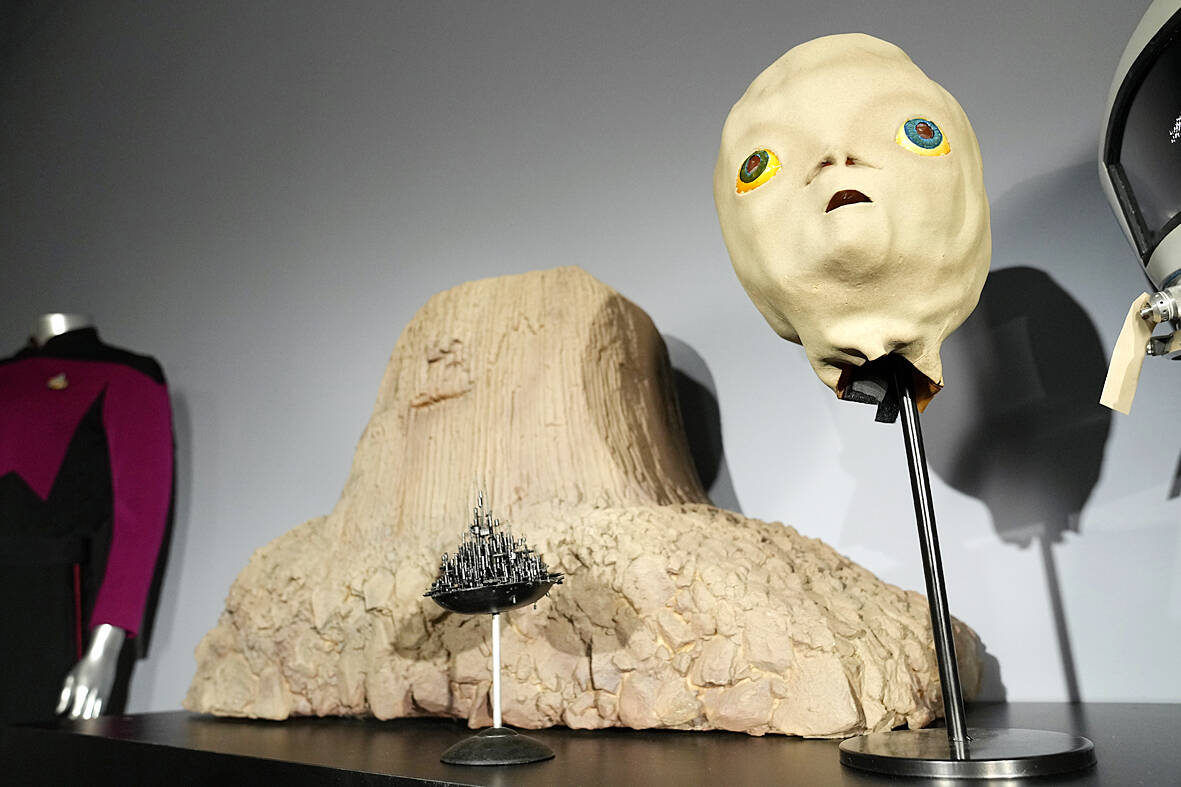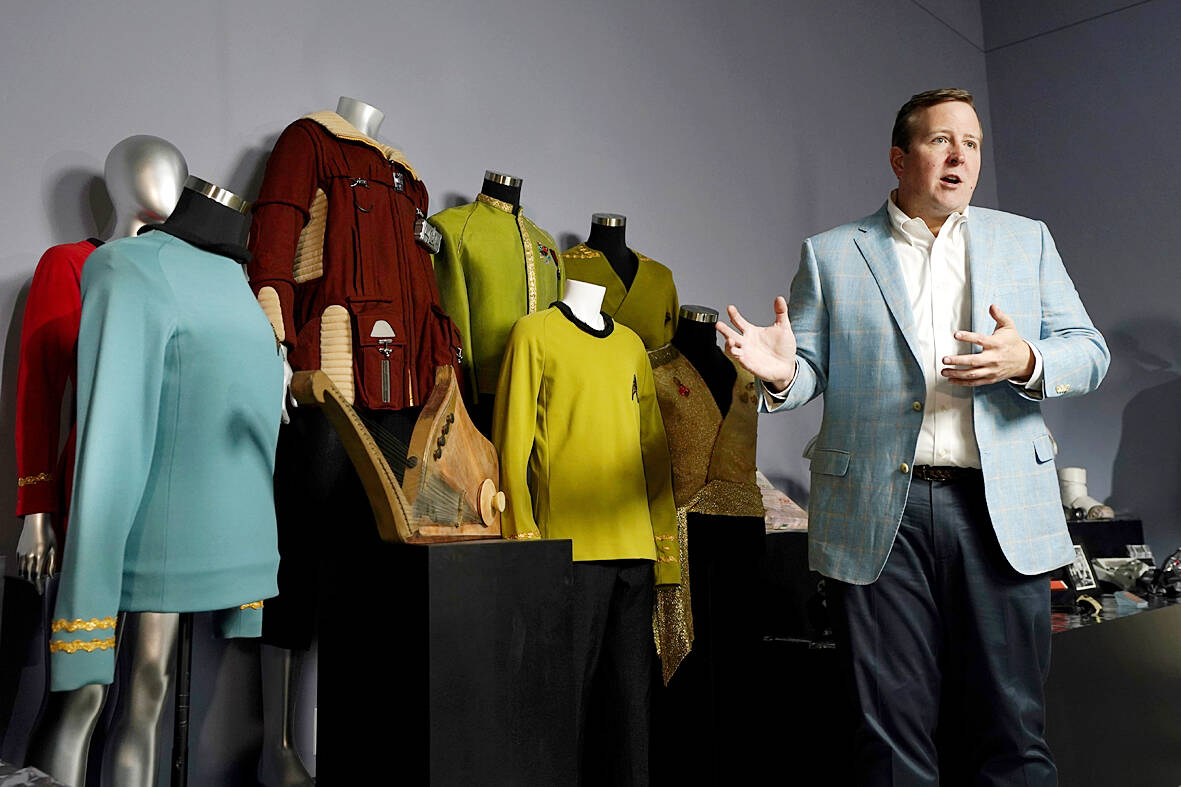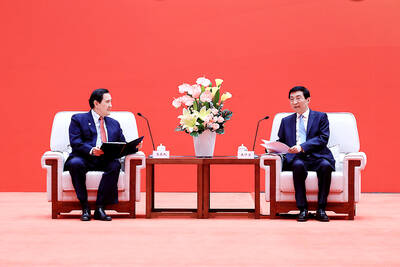From an early model of the iconic alien mothership from Close Encounters of the Third Kind to a complete Stormtrooper costume from Star Wars, bidding opened yesterday on thousands of pieces Hollywood model maker Greg Jein collected over his lifetime, including many he created during his nearly half-century career.
The collection amassed by Jein, who died last year at age 76, will be offered up by Heritage Auctions next month in Dallas. Jein, who had an Oscar and Emmy nominated career making miniature models, was also a collector of costumes, props, scripts, artwork, photographs and models from the shows he loved.
“He spent his entire lifetime in a movie industry at a time when practical effects and models were the way that magic happened,” said Joshua Benesh, Heritage’s chief strategy officer. “They were the way that spaceships traveled through outer space. They were the way that aliens came and visited Earth. They were the way that catastrophes and disasters were depicted.”

Photo: AP
Jein, who grew up in Los Angeles, began his career in the mid-1970s, and over the decades worked on movies including The Dark Knight Rises, The Hunt for Red October and Avatar. A fan of Star Trek from the start, he later worked on pieces for the franchise.
Jein was still early in his career when he led the team that created the mothership for Steven Spielberg’s 1977 film Close Encounters of the Third Kind. The model that appears in the movie — just over 1.5 meters long but appearing gigantic — is now part of the collection at the Smithsonian’s National Air and Space Museum. But a small preliminary model, which is about 12 centimeters long, is among Jein’s creations that will be offered at the auction.
“It is equal parts incredibly intricate and just sort of incredibly simple,” Benesh said. “It has this sort of whacked together informal quality to it but you see it and you know exactly what it is.”

Photo: AP
Other creations from Jein’s career going up for auction include a miniature wrecked spaceship from the 1997 film Starship Troopers and a miniature shack, airplanes and newspapers from Spielberg’s 1979 war comedy 1941.
Also being offered up are a dizzying number of items Jein collected from the 1960s Batman television show and the Star Trek and Star Wars franchises. The Batman memorabilia includes Batarangs, utility belts and a Bat radio. There are phasers, communicators and tricorders from Star Trek: The Original Series from the 1960s, in addition to many costumes, including the formal dress tunic William Shatner wore as Captain Kirk. Jein even had the Vulcan lute played by Leonard Nimoy’s “Mr. Spock.”
Then there’s the “Red Leader” X-wing Starfighter miniature complete with a pilot and the top of an R2 unit that was used in the 1977 film Star Wars: Episode IV — A New Hope.
Lou Zutavern, Jein’s longtime friend and shop supervisor, said Jein had a love for Hollywood history and a passion for collecting.
“He loved the search and finding things and making a trade,” Zutavern said. “It was part of the fun for him but he also really wanted to make sure the stuff didn’t just get thrown in dumpsters.”
Even as a child, Jein was not only a collector, but already an exacting model maker, said his cousin, Jerry Chang. Jein collected baseball cards, comic books and toys, buying one toy to play with and one to keep, Chang said.
When Jein was around 10, he surprised Chang and Chang’s brother following a visit to Disneyland by creating a detailed replica of the theme park in his bedroom.
Jein graduated from California State University, Los Angeles in 1967 with a bachelor’s degree in art. He then spent some time taking graduate courses and eventually embarked on his career in Hollywood.
Chang said that sorting through his cousin’s collection after his death became “sort of like a treasure hunt.”
“You would move a set of books and all of a sudden you’d find something and you’d go: ‘Oh my gosh, that looks kind of familiar,’” Chang said.
Chang said Jein loved his work and also had a passion to learn about a wide array of topics. After Jein died, his cousin found that his book collection spanned topics from cooking to the military.
“He lived the life that he wanted and he enjoyed it,” Chang said.

The canonical shot of an East Asian city is a night skyline studded with towering apartment and office buildings, bright with neon and plastic signage, a landscape of energy and modernity. Another classic image is the same city seen from above, in which identical apartment towers march across the city, spilling out over nearby geography, like stylized soldiers colonizing new territory in a board game. Densely populated dynamic conurbations of money, technological innovation and convenience, it is hard to see the cities of East Asia as what they truly are: necropolises. Why is this? The East Asian development model, with

Desperate dads meet in car parks to exchange packets; exhausted parents slip it into their kids’ drinks; families wait months for prescriptions buy it “off label.” But is it worth the risk? “The first time I gave him a gummy, I thought, ‘Oh my God, have I killed him?’ He just passed out in front of the TV. That never happens.” Jen remembers giving her son, David, six, melatonin to help him sleep. She got them from a friend, a pediatrician who gave them to her own child. “It was sort of hilarious. She had half a tub of gummies,

The wide-screen spectacle of Formula One gets a gleaming, rip-roaring workout in Joseph Kosinski’s F1, a fine-tuned machine of a movie that, in its most riveting racing scenes, approaches a kind of high-speed splendor. Kosinski, who last endeavored to put moviegoers in the seat of a fighter jet in Top Gun: Maverick, has moved to the open cockpits of Formula One with much the same affection, if not outright need, for speed. A lot of the same team is back. Jerry Bruckheimer produces. Ehren Kruger, a co-writer on Maverick, takes sole credit here. Hans Zimmer, a co-composer previously, supplies the thumping

There is an old British curse, “may you live in interesting times,” passed off as ancient Chinese wisdom to make it sound more exotic and profound. We are living in interesting times. From US President Donald Trump’s decision on American tariffs, to how the recalls will play out, to uncertainty about how events are evolving in China, we can do nothing more than wait with bated breath. At the cusp of potentially momentous change, it is a good time to take stock of the current state of Taiwan’s political parties. As things stand, all three major parties are struggling. For our examination of the